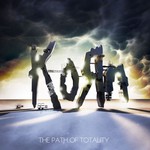The Path Of Totality
Studio Album by Korn released in 2011The Path Of Totality review
Korn fans had it coming
How difficult it is in the present world to please the pampered audience, who seem to be having too wide a range of music pleasures. Today they worship you for the originality of ideas, incomparability of sound and uniqueness of style, and tomorrow, if you offer them the same, you might hear a whole lot of accusations of plagiarism, triviality and reluctance to evolve. Contemporary hard rock giants, American band Korn, found themselves in a situation like that. When they decided to bring back their original sound on last year’s decent record Korn III: Remember Who You Are, it turned out fans were going to find too many faults with this effort. The main one was that they allegedly had already heard something like that. Sure, they had! That would be weird for a performer to create a new genre, enhance it to perfection, sell millions of CDs made in it, and then, suddenly, divert from it. However, judging by the opinions in their audience, Korn, did just that. And they did it on their tenth studio album, The Path Of Totality.
Aggressive electronica
The times when electronica and hard rock shunned each other are long gone, and now, quite oppositely, these two are seen in tight contact more and more often. Rammstein, KMFDM, Die Krupps did not appear yesterday or yesteryear. So this time, there is no ground for us to praise Korn for designing a new trend. Still, it is them who conjured to mix the styles of dubstep and nu metal, which on paper looks savage, but in practice works out quite impressively. And this is no the material of The Path Of Totality that motivated us to speak about dubstep, but rather the names of performers who took part in the making of the album. Some of them are the leaders of the genre, Skrillex, and Noisia, who make up for half the set of the CD. The tracks with the former are closer to the pop side. The title Get Up! says a great part for it. Noisia helped make far more interesting stuff, although structurally very similar. The choruses are very melodic and least aggressive as Davies automatically switches from wild growling to clean singing. Should it be not a Korn album, everyone would happily fall for it, but this IS their record, and here comes an inner voice of indignation asking how they could make choruses of this kind. Nevertheless, My Wall, Sanctuary, and Illuminati are as powerful as the band’s older stuff. Chaotic, slightly dirty sound and, of course, the vibe do what they must.
Same aim, different means
True innovators, Korn had to do something like that of they decided to change their music approach. Once you leave behind subjective arguments about a big metal band so easily and effortlessly applying electronic, and just appraise the impact of the album, you will have to admit that The Path Of Totality is a sheer success. One just has to understand that Korn did not go to the studio to make friends with dubstep. They made friends with dubstep to bring something good out of the studio. The Americans molded the genre they way they felt fit as they slowed it down and flavored it with enough extremeness. Finally, at the end of the set, there is a song that shows Korn are still independent and intended to enjoy what they do. Bleeding On exposes to anyone who can hear the sounds of piano and even bagpipes. It is not their most impressive, nor the most ground breaking album, but this is definitely a very unpredictable and interesting effort from extreme music leaders. Korn have hardly changed their course. They have the same aim, but they might use some different means.

